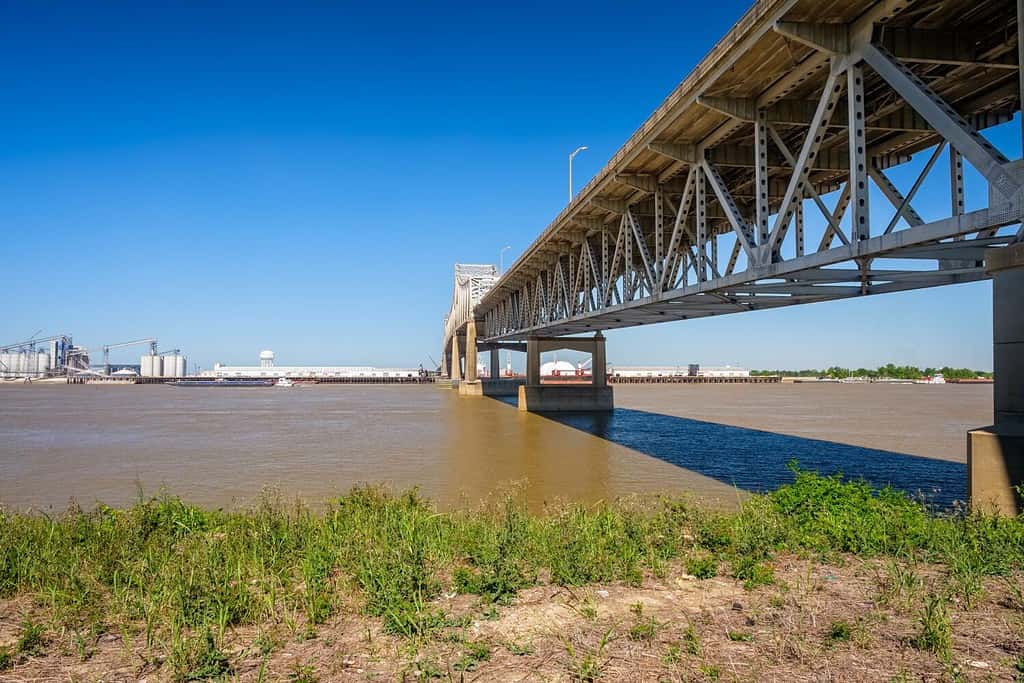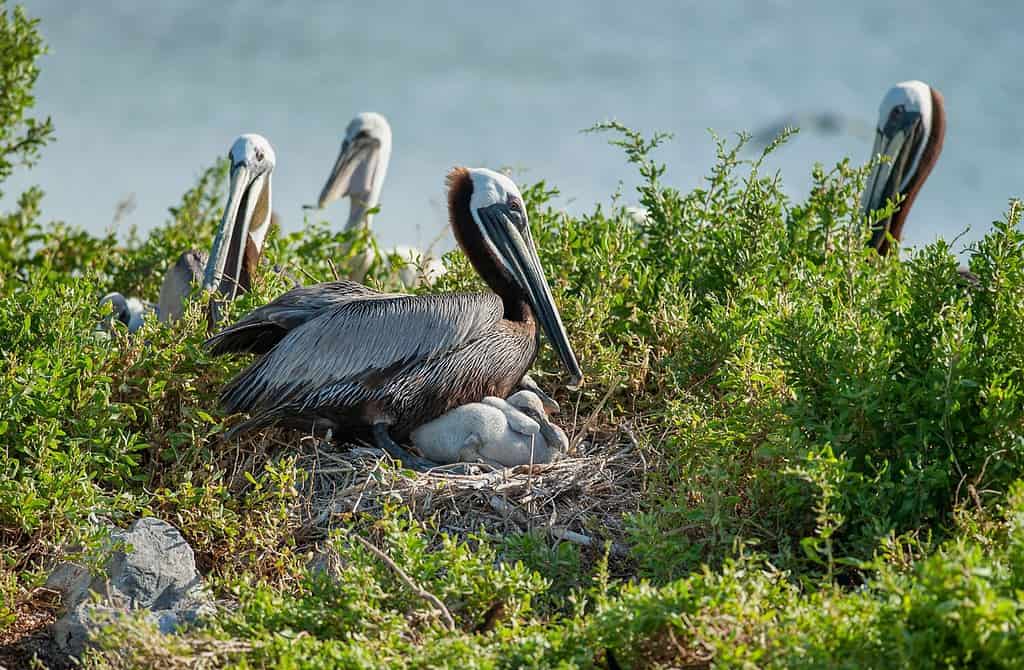How wide is Louisiana, when you take into consideration the state’s unique, boot-like shape? Well, as with all states, the width is determined simply—by measuring the distance, east to west using the state’s widest portion. In this case, it would be the bottom of the boot.
Louisiana is 130 miles wide, or 231 kilometers from east to west. Interstate 10 crosses from east to west, at the very bottom of the state, and is 274 miles long, because it often deviates from an east or west direction, traveling north or south through certain parts of the state.
Becoming a Part of the United States

Landscape view of the Baton Rouge bridge on Interstate 10 over the Mississippi River in Louisiana.
©Fotoluminate LLC/Shutterstock.com
Louisiana’s history and culture are distinctly French. As a French colony from 1731 to 1763, it was ceded to Spain before again falling under French control in 1800. Unfortunately, for the French, the second time was not a charm. Napoleon Bonaparte sold France to the United States just three years later, in 1803.
However, only the Southern portion (the part in the “how wide is Louisiana” measurement) became a state in 1812. Historically, Louisiana was the first state west of the Mississippi. As a part of the Louisiana Purchase, gaining Louisiana was quite a steal.
At the time of the purchase, there was nothing outlining the borders of the state. Technically, it had no Western border. How wide Louisiana was, at the time of the purchase, was a complete head-scratcher. Nobody knew. Even worse, there was a ton of internal conflict over the purchase, with many accusing Thomas Jefferson of acquiring it outside the boundaries of the law.
The purchase also gave rise to increased tensions between France and Spain, as Napoleon Bonaparte owed Spain compensation for the sale. In the meantime, internal U.S. disputes over boundaries boiled down to the Rio Grand or the Sabine River forming the western edge of the state.
Fortunately, Gen. James Wilkinson got rid of the problem by offering a compromise, drawing a new border between the Sabine River and Arroyo Hondo. This was acceptable enough for every side and proceedings for admitting Louisiana into the Union began in earnest.
All of the above infighting, along with French and Spanish disputes, were the reason Louisiana was purchased in 1803 but didn’t become a state until 1812, nearly a decade later.
Geography of Louisiana

Bald cypress trees in Louisiana.
©Norm Lane/Shutterstock.com
Everyone knows that the southern part of Louisiana, especially the New Orleans area, is below sea level. This is a major reason that cities like New Orleans place their dead in vaults above the ground. You can still bury your dead in the state, but only in areas where the water table doesn’t threaten to push the coffin up and out of the ground every time a rainstorm comes along.
Nearly the entire state of Louisiana, especially the entirety of the south, is the result of thousands of years of sediment deposits from the Mississippi River. Southern regions are often marshlands. North of Lake Pontchartrain, however, the land rises and rolling hills become a predominant feature.
To reach the state’s highest point, you have to travel to Driskill Mountain, which sits at 535′ above sea level. Though New Orleans is 8′ below sea level, the northeastern part of Louisiana very nearly touches the edge of the Appalachian Mountains.
Louisiana has a total area of 51,839.7 miles², making it the 31st largest state in the U.S. However, the land area only covers 43,561 miles², with a shade over 49% of the state covered in forests. Water areas extend across 8,277 miles², making up a total of nearly 16% of the state.
Some of the water regions throughout Louisiana merge with forest as well, via marshlands for the most part. Louisiana’s official dimensions are 380 miles x 130 miles. However, since it’s kind of shaped like a boot, those dimensions are based on the bottom width and the north and south length.
Wildlife in Louisiana

Nesting Brown Pelicans on Queen Bess Island in Coastal Louisiana
©Bonnie Taylor Barry/Shutterstock.com
It doesn’t matter how wide Louisiana is when it’s positively stuffed with every Southerner’s favorite animals. Louisiana is an absolute treasure trove of wildlife, especially since it has 6 ecoregions.
- Western Gulf Coastal Plain
- South Central Plain
- Southeastern Plain
- Mississippi Alluvial Plain
- Mississippi Valley Loess Plain
- Southern Coastal Plain
These ecoregions all contain a number of subregions, each of which hosts hundreds, if not thousands, of species of mammals, fish, insects, birds, and vegetation. Louisiana is known for its alligators, though that is far from the only reptile in the state. The marshlands of Louisiana may seem scary and spooky to some, but the reality is quite the opposite.
A typical morning in Louisiana’s marshlands is a veritable wonder of wildlife, from the deep bass cadence of the American bullfrog, bird-voiced tree frog, and American toad to the unturned violin whine of cicadas. You might hear the splashing of otters or alligators as they hit the water, leaving their nests.
The great blue heron and the great egret wade through the shallow areas, seeking juvenile bass or white perch. coyotes, red foxes, black bears, cougars, bobcats, and wild pigs make their way into the swamp from time to time as well, some more often than others.
All of the abundant wildlife in the marshlands live and die under a dark canopy of cypress trees, draped in the thick, grey, hanging curtains of Spanish moss. When the sun does penetrate, it’s in well-defined, golden bars that penetrate the morning fog and mist. It’s a stunningly beautiful environment and a far cry from how it is often presented on TV.
Northern Regions
Thanks to how wide Louisiana is in the south, there is a ton of marshland, stretching from the eastern portion of the state into the west, with a few breaks in between. However, though the swamp is the face of Louisiana, it’s not the largest part of the state’s wildlife. Not by a long shot.
The dryer parts of Louisiana are just as thriving with wildlife as the south, including big brown bats, long-tailed weasels, the Louisiana black bear, gopher tortoises, armadillos, pygmy rattlesnakes, and eastern wild turkeys.
For the most part, every type of animal that lives in the marshlands is also located up north as well. The only exception would be the manatee, which only shows up at certain times of the year. Though the American alligator is far more common in marshland environments, it’s also found in northern regions of Louisiana, anywhere near large bodies of water.
Where is Louisiana Located on a Map?
Louisiana is a southeastern U.S. state bordering the Gulf of Mexico and boasts a rich history as a vibrant mix of French, African, American, and French-Canadian cultures. This diverse heritage is beautifully showcased through its unique Creole and Cajun traditions.
Here is Louisiana on a map:
Final Thoughts
How wide Louisiana is could be two different responses, depending on where the measuring takes place. However, for the most part, the width of the boot (or the southern part of the state) is the part that gets the measuring treatment, coming in at 130 miles from east to west.
Overall, Louisiana is a lot smaller than it looks on a map, with 30 states larger than the Bayou State. It’s a surprisingly beautiful state, despite what may be presented in the latest horror movie. There’s something hauntingly mysterious and eerily serene about south Louisiana’s marshlands—a feeling that can’t be translated to film very well.
A ton of wildlife calls Louisiana home, whether it’s the northern half, with rolling hills and plenty of sunshine, or the deepest recesses of the swamp. We got a heck of a deal with Louisiana when Thomas Jefferson welcomed the state into the Union.
The photo featured at the top of this post is © f11photo/Shutterstock.com
Thank you for reading! Have some feedback for us? Contact the AZ Animals editorial team.







